This week, Wine Lister published Part II of its annual in-depth Bordeaux Study, In sickness, in health, which, among other inquiries, examines the 40 top-quality crus in 2019. As illustrated in the study, tastings have so far indicated high quality levels across the board in 2019, while numerous wines have made significant advancements, shaking up this year’s rankings.
Following this line of investigation, below we examine the top 25 Bordeaux 2019s by WL score (as separated by mere decimals), and consider the biggest movers since last year. These scores are informed by the recently-released ratings of Wine Lister partner critics, Bettane+Desseauve, Antonio Galloni and Neal Martin for Vinous.com, and James Lawther for JancisRobinson.com.
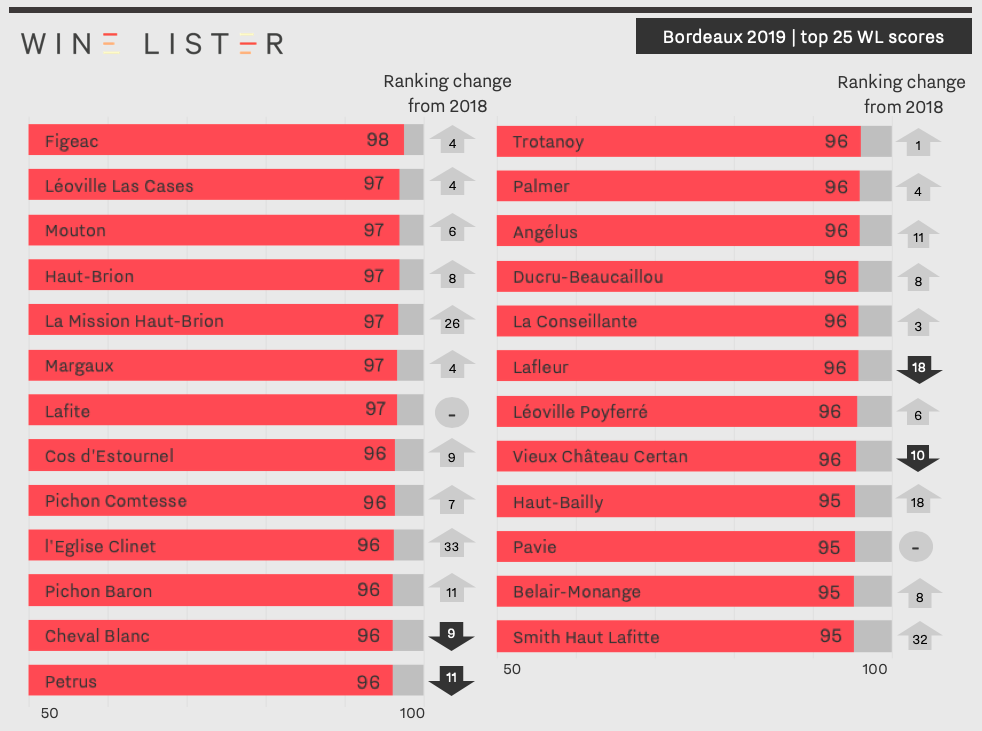
Consistent with last year’s ranking of Bordeaux 2018s by Quality score (conducted before the introduction of Wine Lister’s free site, featuring WL scores out of 100), Pomerol earns the highest number of places (six) in the top 25 2019s by WL score. Neighbouring Saint-Emilion follows closely behind with five spots in this year’s ranking, including the top-scoring wine of the vintage, Figeac 2019, which achieves a WL score of 98.
The four first growths to release their 2019s en primeur appear in third through seventh places, intersected by La Mission Haut-Brion’s entry at fifth place. This promising Pessac-Léognan climbs an impressive 26 spots in 2019, and, as mentioned in our previous blog, has been recently assigned MUST BUY status. Neal Martin scores La Mission Haut-Brion 2019 98-100 points, declaring: “I wager that ultimately this will become one of the wines of the vintage”, concluding that the wine is “breathtaking”.
L’Eglise Clinet sees an impressive upwards shift of 33 places this year, entering the top 10 with a WL score of 96. A poignant tribute to its late winemaker, Denis Durantou, its 2019 has received significant praise, with Antonio Galloni noting that it is “very clearly one of the wines of the year. A Pomerol of soaring, majestic intensity, L’Eglise-Clinet dazzles from start to finish”.
Pichon-Baron and Angélus both climb eleven places in this year’s top-25 ranking, to 11th and 16th place, respectively, with the former receiving top scores from both Neal Martin and Antonio Galloni. Both critics allude to the depth of Pichon-Baron’s 2019, with Galloni stating that “pomegranate, chocolate, licorice and spice are all lavishly expressed”. This represents one of Pauillac’s four entries on this year’s top-25 ranking, which also comprises Mouton, Lafite, and Pichon Comtesse.
Haut-Bailly makes a sizeable leap of 18 places since last year, ranking in 21st place with a WL score of 95. At £70 per bottle (in-bond) Haut-Bailly 2019 is also a Wine Lister MUST BUY. Fellow Pessac-Léognan producer, Smith Haut Lafitte, climbs an impressive 32 places with its 2019 vintage, rounding out the top 25 list. Having tasted twice, Neal Martin describes its “intense, very pure bouquet with blackberry, briary and cherry compote and a hint of black olive tapenade in the background”.
Also featured in the top 25 Bordeaux 2019s by WL score are: Belair-Monange, Cheval Blanc, Cos d’Estournel, Ducru-Beaucaillou, Haut-Brion, La Conseillante, Lafleur, Léoville Las Cases, Léoville Poyferré, Margaux, Palmer, Pavie, Petrus, Trotanoy, and Vieux Château Certan.
Wine Lister Pro members can read Part II of the Bordeaux study here. All free users can purchase the report for £125 from Wine Lister’s Analysis page (available in both English and French).
With the Bordeaux 2019 en primeur campaign now concluded, we bring you 38 new Wine Lister MUST BUYs. The tasting of Bordeaux 2019 has thus far confirmed the notable quality of the vintage, from which we have filtered some obvious campaign buys that can be expected to see increased prices, and decreased availability in the future.
Wine Lister’s MUST BUY recommendation algorithm takes into account a wine’s quality and value within its vintage and appellation, as well as the latest industry intelligence from key players in the global fine wine trade. These results are then filtered through an intelligence-based, human overlay, which identifies MUST BUY wines based on our tasting of Bordeaux 2019, and observation of the reception of each release in the market.
As illustrated below, there are 38 Bordeaux 2019s that are now recognised as MUST BUYs – suggesting that the benefit of buying en primeur is more obvious than last year (there were 24 Bordeaux 2018 en primeurs recognised as MUST BUYs following its campaign). They are all red:
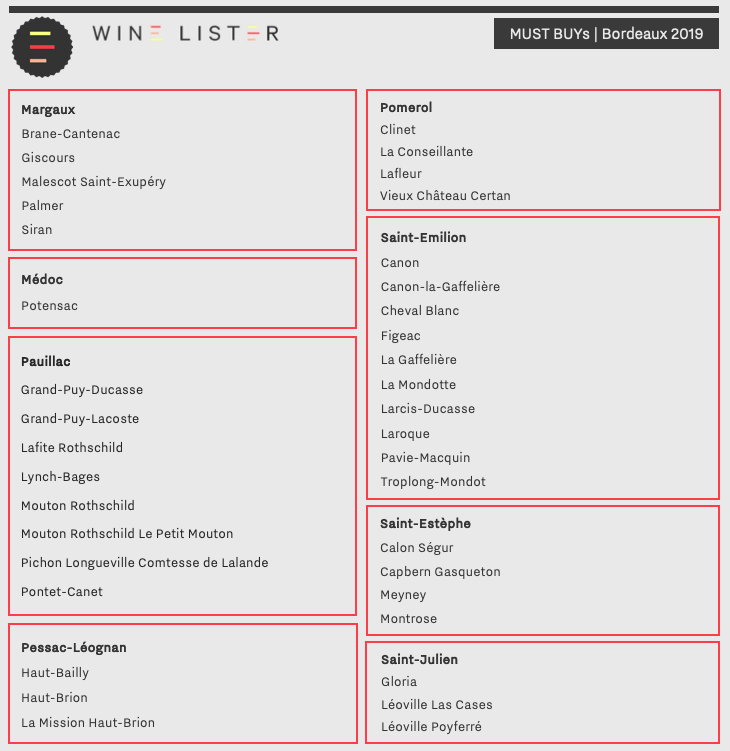
In keeping with last year’s MUST BUY picks, Saint-Emilion once again ranks as the most recommended appellation – this year offering 10 MUST BUYs, including the top-scoring wine of the vintage: Figeac 2019. With a WL score of 98, Figeac’s latest vintage has sustained the château’s upward quality trajectory.
With a WL score of 93 at £18 per bottle (in-bond), Laroque 2019 exhibits excellent value relative to 2019 Saint-Emilions of comparable quality. Alongside its MUST BUY status, Laroque’s latest vintage is also a Value Pick, making it an essential acquisition for the savvy Bordeaux buyer. Wine Lister partner critic, Antonio Galloni, notes, “raspberry jam, spice and red plum meld into the juicy finish”, stating that “the 2019 is very nicely done”.
Pauillac houses eight Bordeaux 2019 MUST BUYs, including first growths Lafite and Mouton, which both achieve WL scores of 97. Grand-Puy-Ducasse 2019 is both a MUST BUY and a Value Pick, having achieved a WL score of 93 at £23 per bottle (in-bond). Writing for Jancisrobinson.com, James Lawther muses whether the 2019 is the, “best of recent vintages?”, suggesting that it “certainly has more structure and power with additional mid-palate flesh”. As proposed in a previous Bordeaux 2019 en primeur blog, Pichon Comtesse is another notable Pauillac purchase for wine collectors, given the estate’s impressive popularity, and its vast reduction in volume released this year.
Within its five MUST BUY picks (four at under £50 per bottle in-bond), Margaux contains two Value Picks, with Malescot Saint-Exupery and Siran priced at £31 and £20 per bottle (in-bond), respectively. At £167 per bottle (in-bond) Palmer 2019 shows good value within the context of its previous vintages (31% below the 2018 and 2016 release prices), which, alongside its limited quantity released en primeur, makes this a must for Margaux enthusiasts.
In Pomerol, La Conseillante, Lafleur, and Vieux Château Certan achieve WL scores of 96, while Clinet follows shortly behind with 95. At £54 per bottle (in-bond) the latter is notably cheaper than its Pomerol peers, and has made a major leap up in quality from previous vintages. Awarding it 97-99 points, Neal Martin writes that Clinet 2019 “is just so fragrant on the nose”, stating that, “the purity that Ronan Laborde and his team have achieved should be applauded”.
Calon Ségur and Montrose lead Saint-Estèphe’s four MUST BUYs with a shared WL score of 95, while Meyney and Capbern provide testament to the value proposition available in the appellation, having been priced at £19 and £15 per bottle (in-bond), respectively.
Sharing three picks apiece are further left bank appellations Saint-Julien and Pessac-Léognan, which are both home to high-scoring 2019s. In Saint-Julien, Léoville Las Cases achieves a WL score of 97 – matched by Pessac-Léognan first growth Haut-Brion, and neighbour, La Mission.
Other wines featured in Wine Lister’s Bordeaux 2019 MUST BUYs are: Brane-Cantenac, Canon, Canon-la-Gaffelière, Cheval Blanc, Giscours, Gloria, Grand-Puy-Lacoste, Haut-Bailly, Le Petit Mouton, La Gaffelière, La Mondotte, Larcis-Ducasse, Léoville Poyferré, Lynch-Bages, Pavie-Macquin, Pontet-Canet, Potensac, and Troplong-Mondot.
Wine Lister has now released Part II of its annual in-depth Bordeaux Study, examining the price and quality of Bordeaux 2019, relative to previous vintages. Purchase the full report here, or download using your Pro subscription (available in both English and French).
Despite wide speculation over whether an en primeur campaign could proceed at all in 2020, this year’s campaign is now more or less complete, and Wine Lister’s scores are in. Bordeaux 2019s exhibit high quality across the board, receiving frequent comparison with recent great vintages – 2016, 2015, 2010, and 2009.
Wine Lister has now published its latest Wine Leagues on the new vintage – examining which Bordeaux 2019s rank best for WL score in each major appellation.
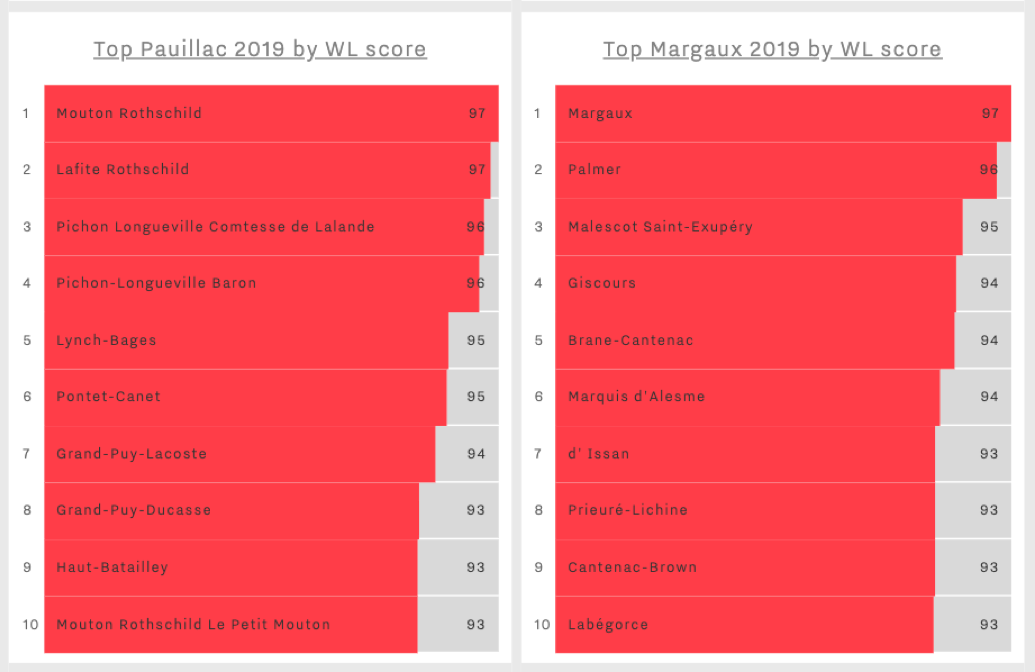
Pauillac First Growths, Lafite and Mouton, lead the appellation’s league of top 2019s by WL score, with a joint score of 97. Pichon Comtesse and Pichon Baron follow suit with 96 – the latter achieving its highest WL score since its 2016 vintage. Wine Lister partner critic Neal Martin describes Pichon-Baron 2019 as having “a very refined bouquet” and a “silky smooth, creamy texture”, stating it “retains all the classicism you could ask for”.
The league of Margaux 2019s by WL score is topped by the appellation’s namesake property, whose latest release joins fellow Pauillac Firsts with a score of 97. Following Palmer’s entry with 96, Malescot Saint-Exupéry 2019 achieves the château’s highest ever WL score (95). Wine Lister partner critic, Antonio Galloni notes that the 2019 is “a striking wine that is sure to find many admirers”, recounting an “interplay of earthy and savoury notes with rich, dense fruit… utterly captivating”.
There are four Value picks featured in the league of Margaux 2019s by WL score, with Labégorce, Malescot Saint-Exupéry, Marquis d’Alesme, and Prieuré-Lichine all achieving scores of 93 and above, at under £35 per bottle (in-bond).
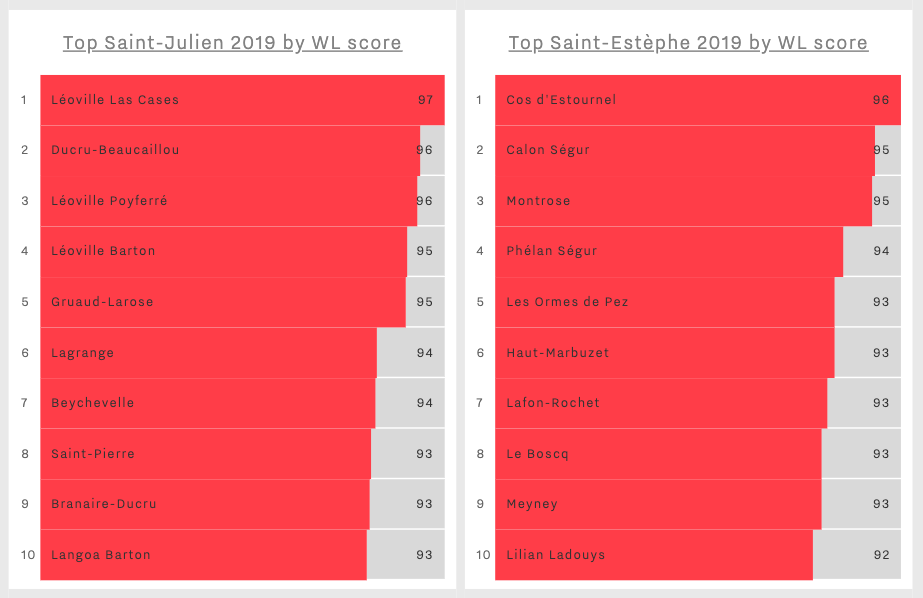
In Saint-Julien, Léoville Las Cases 2019 achieves a WL score of 97, matching that of its 2018 and 2016 vintages. Ducru-Beaucaillou and Léoville Poyferré appear in joint-second place with 96 – achieving their highest WL scores since 2016 and 2015, respectively. Ducru-Beaucaillou 2019 performed notably well at tastings, with Neal Martin, awarding it 96-98 points. He notes its “filigree tannins, pitch perfect acidity and a sensual, satin-like texture”, concluding that the wine is “outstanding in terms of persistence”.
With a score of 96, Cos d’Estournel 2019 tops the league for Saint-Estèphe 2019s by WL score, matching its successful 2018 and 2016 vintages. Writing for JancisRobinson.com, James Lawther describes the vintage as “powerful but carefully constructed and precise”, noting “a lovely mellow quality to such a muscular wine”. While both falling one WL score below their previous vintage, Calon Ségur and Montrose appear second in the appellation’s league, with a shared score of 95.
Branaire-Ducru 2019 and Meyney 2019 exhibit notable value within their appellations – both achieving WL scores of 93 at £29 and £19 per bottle (in-bond), respectively.
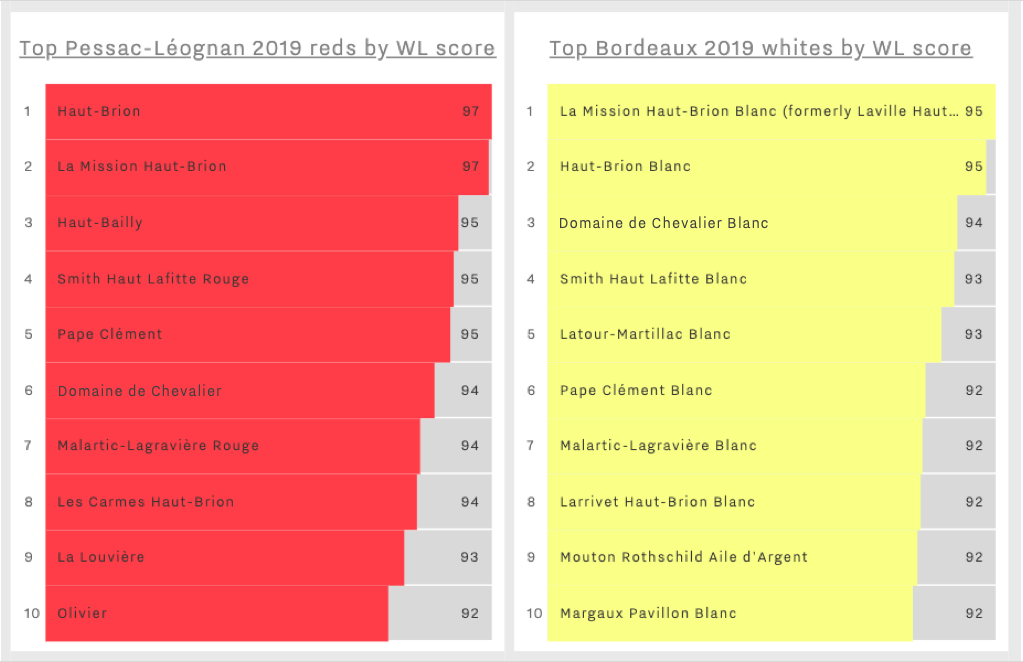
Haut-Brion and La Mission Haut-Brion perform notably well in 2019, achieving joint-first place in the league of top Pessac-Léognan 2019 reds by WL score. As examined in a previous Bordeaux 2019 en primeur blog, the en primeur darling, Les Carmes Haut-Brion, shows clear qualitative success in 2019, and its small production levels and smart en primeur pricing has once again made it a clear campaign buy. Another promising pick from Pessac-Léognan, Olivier 2019 achieves Value pick status at c.£20 per bottle (in-bond), and achieves the château’s highest WL score (92). Antonio Galloni recounts “smoke, licorice, cured meat, graphite and savory herbs infuse the 2019 with striking aromatic intensity to play off its sumptuous fruit”, concluding that the wine is “Very good”.
Haut-Brion and La Mission Haut-Brion attain joint-first place for their whites as well as reds in 2019, achieving scores of 95 in the league of top Bordeaux 2019 whites by WL score. Latour-Martillac Blanc 2019 achieves the highest WL score seen across its vintages (93) – one WL score above Pape Clément Blanc’s 92. At c.£21 per bottle (in bond) Latour-Martillac Blanc 2019 enters the market 10-30% below the current market prices of vintages 2016-2018, showing good value for its quality. Neal Martin notes on the latest vintage: “subtle tropical notes of pineapple and orange rind with hints of strawberry come through on the finish”.
On the right bank, the league of top 10 Saint-Emilion 2019s is crowned by Figeac’s high-scoring 2019. Up one point on its 2018, Figeac’s latest release achieves the highest WL score of all Bordeaux 2019s (98). Figeac 2019 illustrates the château’s impressive upward quality trajectory, which has seen its WL score slowly but surely increase from 91 in 2008. Neal Martin gives the latest vintage 97-99 points, describing it as “exquisitely defined… a deeply impressive, intellectual Figeac”.
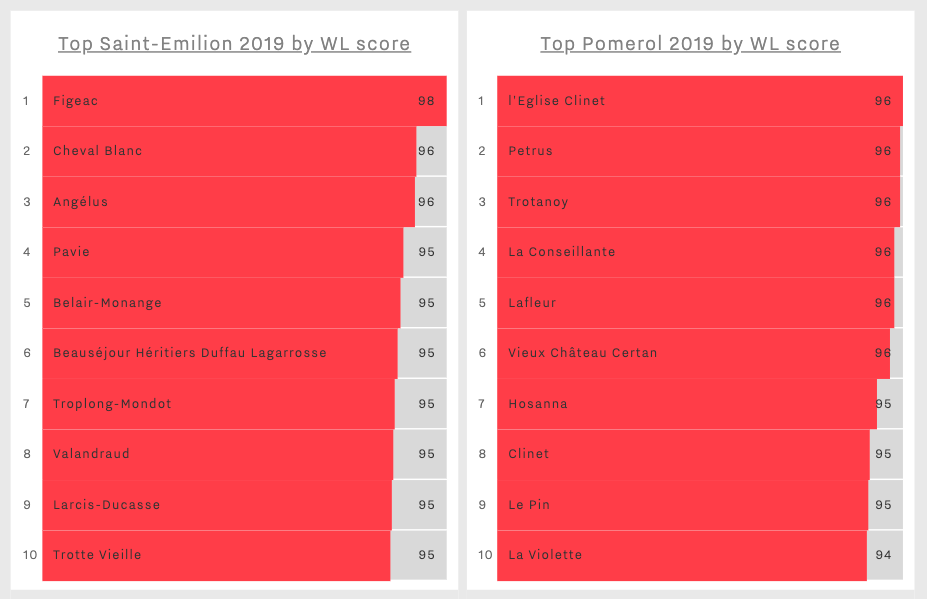
La Conseillante, Lafleur, l’Eglise Clinet, Petrus, Trotanoy, and Vieux Château Certan share the top WL score of Pomerol 2019s (96), separated by mere decimals. A release of note, l’Eglise Clinet 2019 is the last vintage of the late Denis Durantou, who sadly passed away in May. Neal Martin’s impressive score of 97-99 suggests the last vintage was his best, adding, “the perfect way to remember and raise a toast to one of Pomerol’s finest vignerons”.
Click here to view all Wine Leagues. Pro users have access to a more extensive set of Leagues and can log in to access here.
Throughout the late 20th century, Riesling gained a somewhat tarnished reputation, particularly within the UK, as a consequence of the abundance of overly sweet, low-quality Rieslings being released onto the market. Over the past two decades, however, it has made a comeback – especially the dry styles of top-quality wines with ageing potential and great value. The high acidity and complexity of tertiary flavours in Riesling have led to it being a favourite among wine industry professionals, including Jancis Robinson, who hails it “the greatest white wine grape”.
To help you uncover Germany’s noble grape, this week we examine some iconic dry and off-dry Riesling MUST BUYs with WL scores above 95.
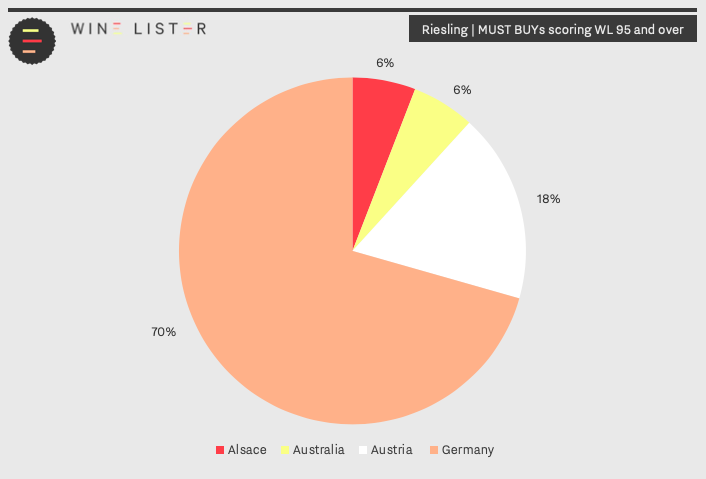
Top quality Riesling is now produced around the world, from the traditional regions of the Mosel and Alsace, through to Australia and South America. 70% of dry Riesling MUST BUYs scoring above WL 95 hail from Germany (25 wines), of which just over half (19 wines) are produced in the Mosel. The other German regions in the list comprise two entries from the Rheinhessen, and one each from the Rheingau, Nahe, and Pfalz respectively.
Austria achieves six entries on the list of Riesling MUST BUYs scoring WL 95 and over (18%), which all hail from Niederösterreich, while the Alsace and Australia’s Clare Valley both earn two entries respectively.
A Mosel Must – 2010 Joh. Jos. Prüm Wehlener Sonnenuhr Riesling Auslese Goldkapsel
With a WL Score of 97 at just £59 (per bottle in-bond), the 2010 Wehlener Sonnenuhr Auslese Goldkapsel exemplifies the excellent quality-to-price ratio of JJ Prüm’s wines. Long considered one of the Mosel’s, if not the whole of Germany’s most revered estates, its Wehlener Sonnenuhr vineyard is situated on steep south-facing, blue slate slopes, resulting in its complex minerality. Scoring it 19/20 points, Wine Lister partner critic, Jancis Robinson recounts that the 2010 vintage of this off-dry Riesling “Dances out of the glass on the nose. Such delicacy and life! Racy”. This vintage is available to purchase from Lay & Wheeler, where a case of six starts at £330 (in bond).
An essential Alsace – 2008 Trimbach Riesling Frédéric Emile
Dating back to 1626, 13 generations of the Trimbach family have contributed to the estate’s winemaking, now considered one of Alsace’s top properties. Cuvée Frédéric Emile is a blend of two Grand Cru vineyards, Geisberg and Osterberg, that share complex soils of alkaline clay and limestone, producing a wine of intense minerality. Both sites benefit from evening winds (the Tahlwendala), which allow extended ripening periods. The 2008 Trimbach Riesling Frédéric Emile achieves a WL Score of 95, and is available to purchase by the case from Cru World Wines for £390 (in bond).
A need for Niederösterreich – 2013 F.X. Pichler Riesling Kellerberg Smaragd
Described by Jancis Robinson as “Big and opulent with some lychee flavours”, the 2013 was a notably good vintage for F.X. Pichler’s Kellerberg Smaragd. Achieving the best WL Score since 1995 (96), it showcases Pichler’s attempt to refine his style and prioritise purity of fruit and balance over power. Although the narrow stone terraces of the Kellerberg vineyard necessitate farming and harvesting by hand, this wine has an impressive quality-to-price ratio. At £34 (per bottle in bond), the 2013 vintage is also a Wine Lister Value pick, and is available to purchase from BI Wines & Spirits (by the case of 12).
A New World necessity – 2013 Grosset Polish Hill Riesling
Often coined one of Australia’s most renowned Riesling winemakers, Jeffrey Grosset’s Polish Hill plot was planted in 1996, following years of research into the effect of soil, rock, and altitude on Riesling. This eight-hectare plot is thus at 460 metres altitude, ensuring cool nights and longer ripening of its Riesling grapes. Planted in an area termed “hard rock”, the Polish Hill vineyard is situated on a crust of clay over slate, which, alongside the cool growing season, causes stress on the vines, resulting in smaller but more complex-flavoured grapes. The 2013 vintage achieves a WL score of 95, and is available to purchase from Lay & Wheeler for £50 (per bottle in bond).
See the full list of Riesling MUST BUYs here.
After discovering some 500 wines over eight tastings during Burgundy week last week, we are excited to publish our first round of Burgundy 2018 MUST BUYs.
Not all Burgundy 2018s are yet priced in the market, so this list has the potential to grow over the coming weeks – watch this space.
A neat 18 wines have so far made it through the MUST BUY algorithm, passing the artificial and human intelligence tests. That means that according to the critic and price data, they offer high quality and good value in the context of the Burgundy 2018 vintage, and that the global fine wine trade and / or the Wine Lister team deems it worthy of note. Given Burgundy’s general trend for rising prices post-release – these Burgundy 2018s should be snapped up now.
Hailing from across the Côte d’Or, this week’s MUST BUY selection confirms that no one appellation stands out in 2018, as outlined by our founder, Ella Lister, in her short vintage report published earlier in the week.
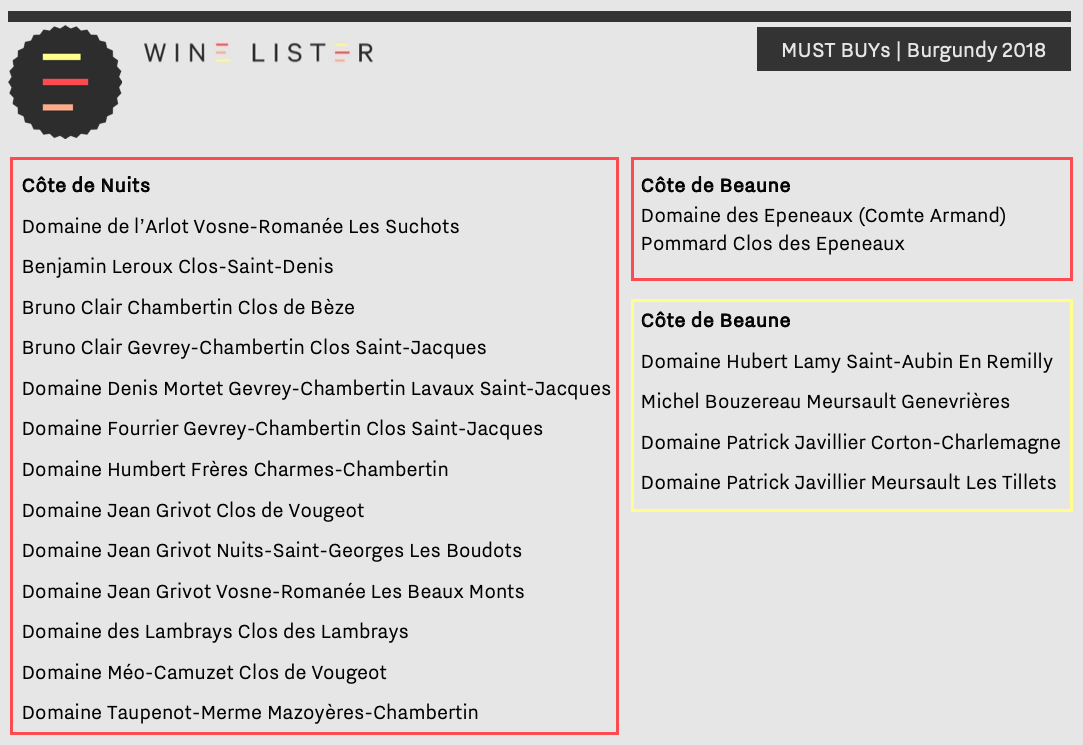
All but one red Burgundy 2018 MUST BUY comes from the Côte de Nuits, with producer Jean Grivot earning three entries – Clos de Vougeot, Nuits-Saint-Georges Les Boudots, and Vosne-Romanée Les Beaux Monts. Bruno Clair has two entries, for his Chambertin Clos de Bèze and Gevrey-Chambertin Clos Saint-Jacques.
From the Côte de Beaune, Comte Armand’s Clos des Epeneaux is the only red to meet all the MUST BUY selection criteria. Of the four whites, the unfailingly consistent Saint-Aubin En Remilly from Hubert Lamy makes the cut, alongside a Meursault Genevrières from Michel Bouzereau, and two wines from Patrick Javillier – Corton-Charlemagne and Value Pick Meursault Les Tillets.
Readers note that this week marks the first MUST BUY update including scores from our new regional partner critic, Jasper Morris.
Thank you to BBR, Corney & Barrow, Flint, Goedhuis, Justerini & Brooks, Lay & Wheeler, and Lea & Sandeman for the wonderful tastings organised!
Wine Lister is excited to announce the arrival of its new consumer site, aimed at supporting fine wine lovers as they navigate the fine wine seas. All users now have unlimited, free access to the world’s most comprehensive fine wine data hub. Start learning how to buy wine like a pro now, or read on to find out more.
WL MUST BUYs
Wine Lister has created its own buy recommendation tool, which combines Wine Lister data with human intelligence (such as the opinion of key members of the global fine wine trade, plus insight from the Wine Lister team’s trips and tastings), to provide a dynamic list of wines any fine wine buyer should consider for their cellar. All MUST BUYs represent high quality, and value within their respective appellations and vintages.
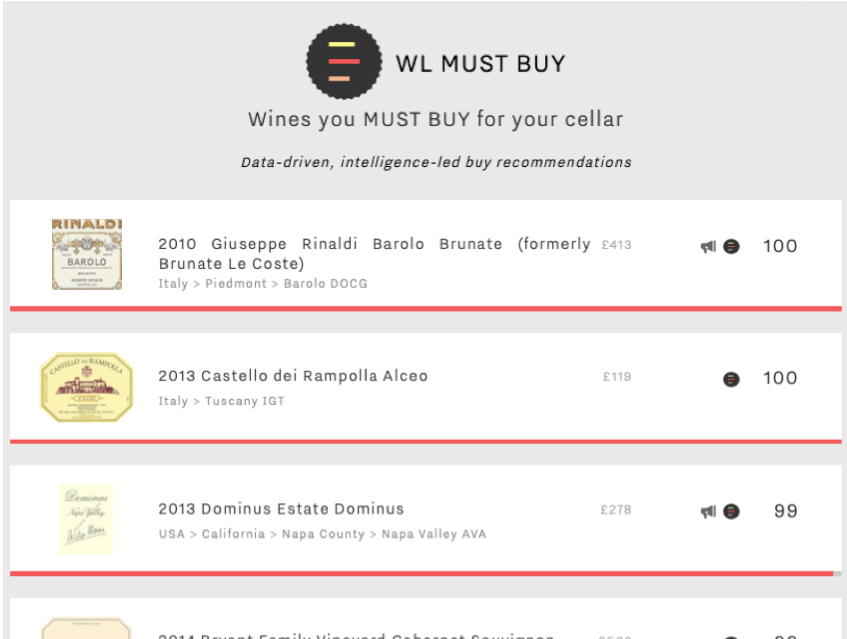 Browse the full MUST BUY list here.
Browse the full MUST BUY list here.
Aggregated, 100-point score
With a focus on quality, the new 100-point Wine Lister Score combines the ratings of five of the world’s most respected wine critics – Jancis Robinson, Antonio Galloni and Neal Martin (Vinous), Bettane+Desseauve, and Jeannie Cho Lee, together with a smaller weighting for the wine’s ageing potential. The score is as objective an indication of wine quality as possible, allowing users to make site-wide comparisons across the 30,000+ wine-vintages on Wine Lister.
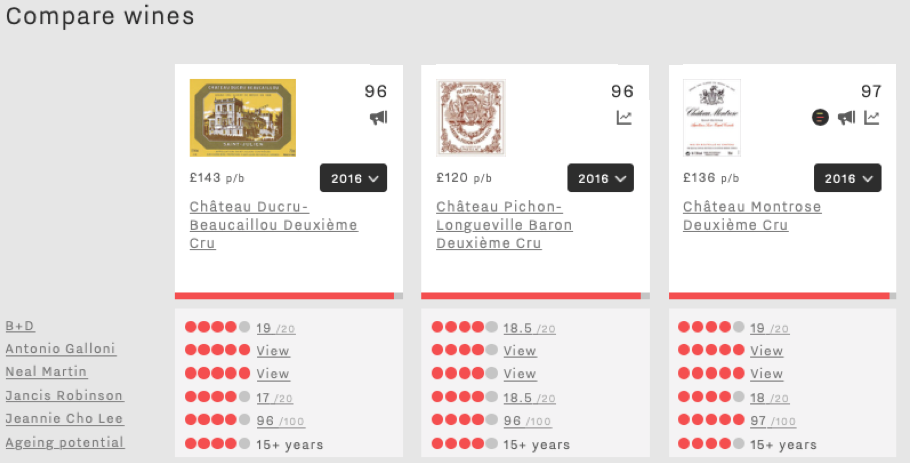
See this comparison, or create your own here.
Further analysis tools
Dynamic charts give users the chance to explore wines they might consider buying or selling in more detail.
The Vintage Value Identifier gives users a clear visual of price to quality ratios across vintages of a given wine, applying a score to this measure of relative value. See the example below for Mouton Rothschild: while the 2016 vintage is higher quality than 2014, its accompanying high price means that both the 2016 and 2014 vintages present the same level of value (the joint-highest of all recent back vintages shown)
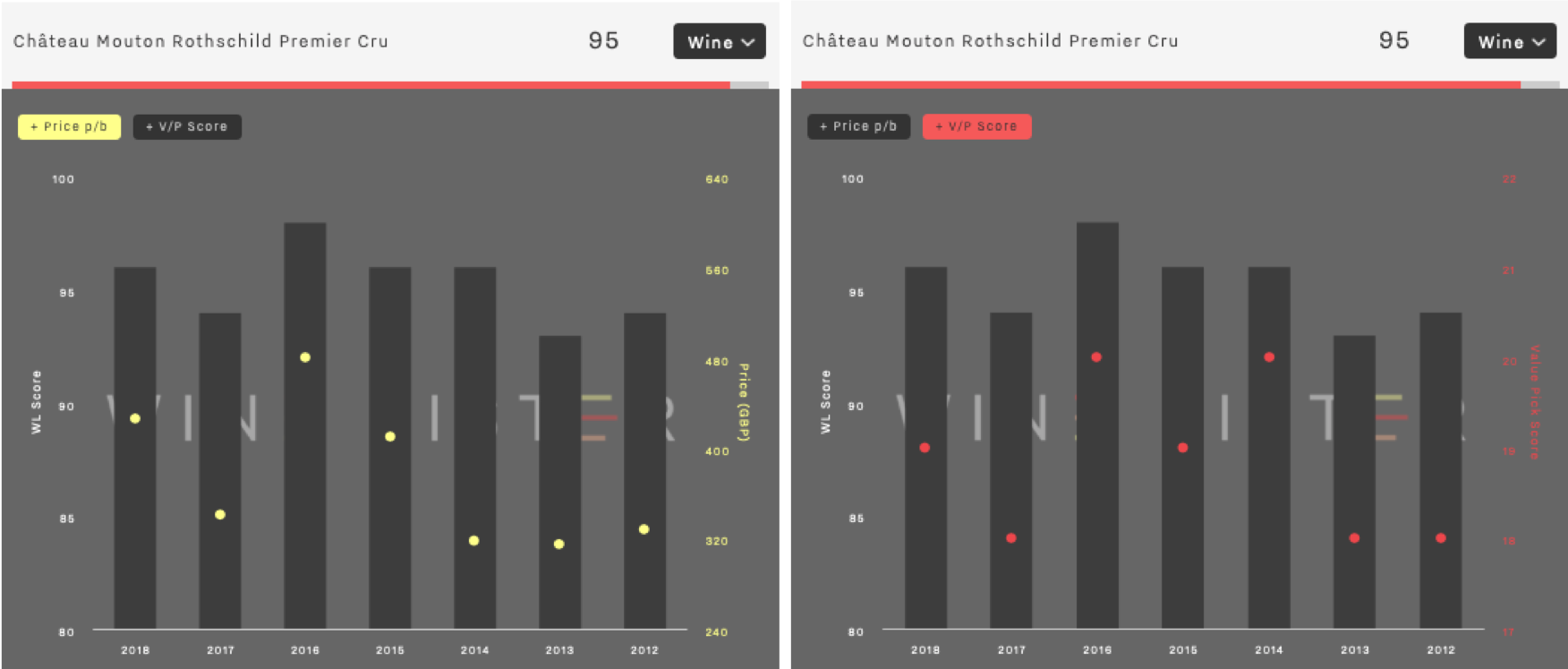 Wine Lister’s dynamic Vintage Value Identifier chart, showing price vs. quality (left) and Value Pick score (right).
Wine Lister’s dynamic Vintage Value Identifier chart, showing price vs. quality (left) and Value Pick score (right).
See the chart for Mouton Rothschild, or search for another wine here.
The Price History chart tracks a wine’s price performance over time, relative to its peer group. This can be done at vintage level, helping collectors to see performance history of a specific wine they might own. See below the example of Domaine Hubert Lignier’s Clos de La Roche 2016, whose price growth over the last year is one of the most impressive of all wines on Wine Lister (57.8%).
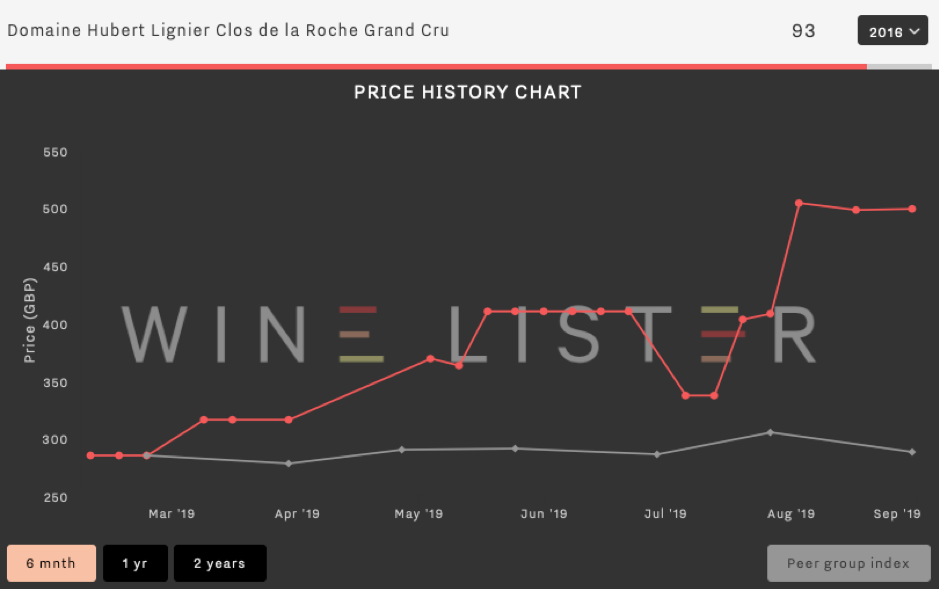 Hubert Lignier Clos de la Roche 2016’s six-month price performance compared to performance of other Clos de la Roche Grand Cru 2016s
Hubert Lignier Clos de la Roche 2016’s six-month price performance compared to performance of other Clos de la Roche Grand Cru 2016s
The same dynamic chart can be used at wine level (an average across vintages, with a stronger weighting for more recent vintages), to give a general indication of a wine’s price trajectory, and therefore whether or not the wine in question could be an investment buy. See below an example for Armand Rousseau’s Chambertin, which on average sees steady price growth, and a CAGR (compound annual growth rate) of 31.8% (though the price has flattened out this year).
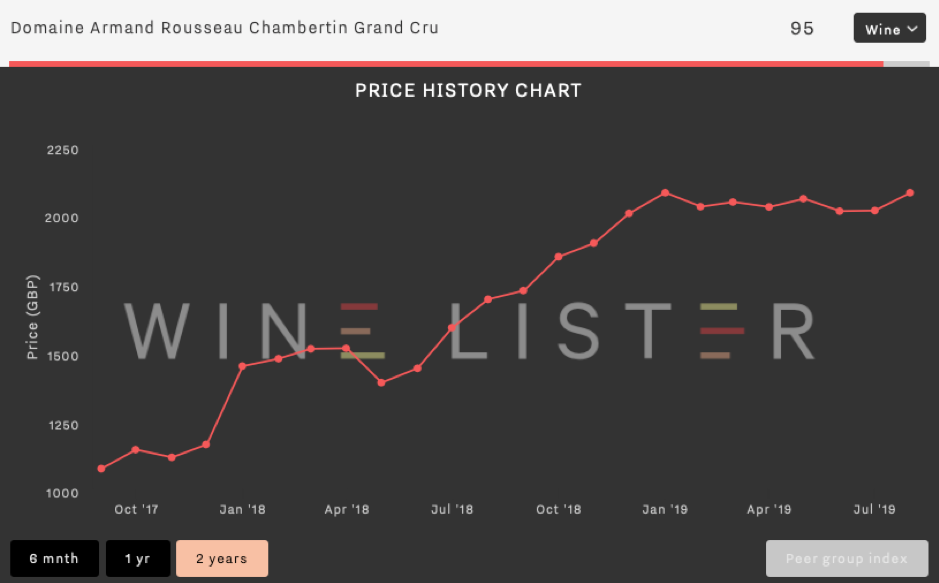 Armand Rousseau’s average price performance over two years
Armand Rousseau’s average price performance over two years
On top of these tools, each wine page gives users further information about the wine in question, including whether the wine qualifies for one of Wine Lister’s four Indicators. Haut Brion, as shown in the example below, is a Buzz Brand. See more information on other segments – Hidden Gems, Value Picks, and Investment Staples, or start browsing here.

We hope that you find the new site informative and useful for developing your fine wine collection. Feedback from our users is always welcome – please don’t hesitate to contact us with any questions or comments here.
In Bordeaux, 2018 was a winemakers’ vintage. That much is clear from conversations the Wine Lister team had throughout en primeur tasting week, explained further in Bordeaux 2018 en primeur part I : the vintage. Though quality across the board was good in 2018, the greats stand out all the more for being the result of key technical decisions, rather than just terroir.
Below we look at the top 25 Bordeaux 2018 red Quality scores, based on the recently-released ratings of Wine Lister partner critics Bettane+Desseauve, Julia Harding for Jancis Robinson, Antonio Galloni for Vinous, and Jeannie Cho Lee. The average Quality score of these top 25 is 975, 25 points higher than the equivalent top red panel in 2017.
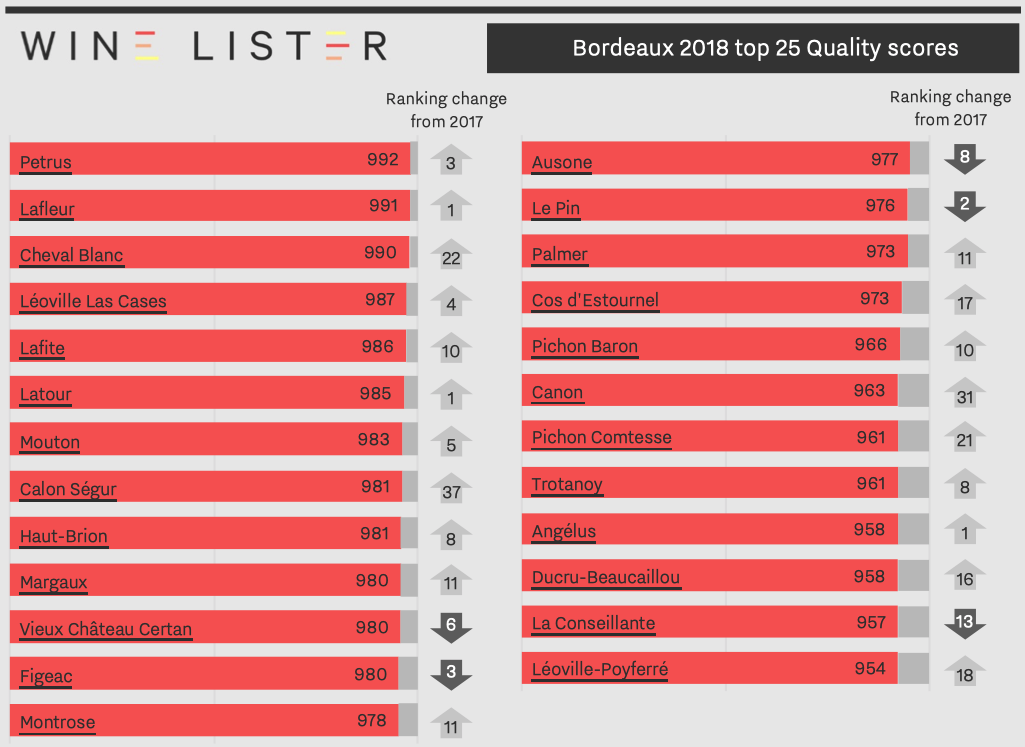
Right bank super-appellation, Pomerol earns the highest number of places in the top 25 red Quality scores (6), and includes the first- and second-best wines of the vintage, Petrus and Lafleur. They earn Quality scores of 992 and 991 respectively, and the former is awarded 97-100 points by Wine Lister partner critic, Antonio Galloni, who comments, “From the very first taste, the 2018 Petrus is simply magical”.
Proving the potential for high quality across both banks in Bordeaux 2018, the next highest appellations are Pauillac and Saint-Émilion with 5 wines appearing in the top 25 apiece. Pauillac wins out overall, with an average score of 976 (vs. 974 in Saint-Émilion). Cheval Blanc (990) and Canon (963) show impressive Quality improvements on 2017, moving 22 and 31 places up the rankings respectively.
Pauillac’s top quality wines are made up, perhaps unsurprisingly, of the three Pauillacais first growths, Lafite (986), Latour (985), and Mouton (983), and super-seconds Pichon Baron and Pichon Comtesse. This last is holds the appellation’s most-improved ranking, moving up 21 places from its 2017 position. Julia Harding of JancisRobinson.com writes of Pichon Comtesse 2018, “A gentle and surprisingly subtle beauty”.
Elsewhere on the left bank, Saint-Julien and Saint-Estèphe earn three wines each in the top 25 for Quality. The best of these, Léoville Las Cases, earns a Quality score of 987. The three Saint-Estèphe wines follow consecutively, with front-runner and rising star Calon-Ségur moving up 37 places from its 2017 ranking – the largest improvement of all the top 25 Quality scorers in 2018.
Margaux and Pessac-Léognan appear just thrice between them in the top 25 for Quality, with Margaux (980), tiny-production Palmer (973), and Haut-Brion (981).
Other wines featuring in the top 25 Bordeaux 2018 Quality scores are: Figeac, Vieux Château Certan, Montrose, Ausone, Le Pin, Cos d’Estournel, Ducru-Beaucaillou, Léoville-Poyferré, Angélus, Trotanoy, and La Conseillante.
With our founder, Ella Lister, just back from tasting the latest releases at Benvenuto Brunello in Montalcino, we thought we’d dig deeper into the data behind the appellation’s top wines. The pyramid system in the region means that most producers make at least three wines: in the middle, a Brunello di Montalcino DOCG Annata (or “vintage”); in good years, a Riserva (with longer ageing but also nearly always the best selection of grapes from the estate); and at the bottom of the pyramid, a Rosso di Montalcino DOC, producing fresher, approachable wines requiring less ageing.
This allows, and indeed encourages, a healthy level of selection in the region. At last weekend’s event, the vintages on show were 2013 Brunello Riserva (excellent), 2014 Brunello Annata (a tricky vintage, with some producers declassifying to Rosso di Montalcino), and Rosso di Montalcino 2017. There is also a trend in the Brunello DOCG towards vineyard-specific crus, such as Casanova di Neri’s Tenuta Nuova or Il Marroneto’s Madonna delle Grazie, both of which feature in this week’s top five: top Brunellos by Economics score.
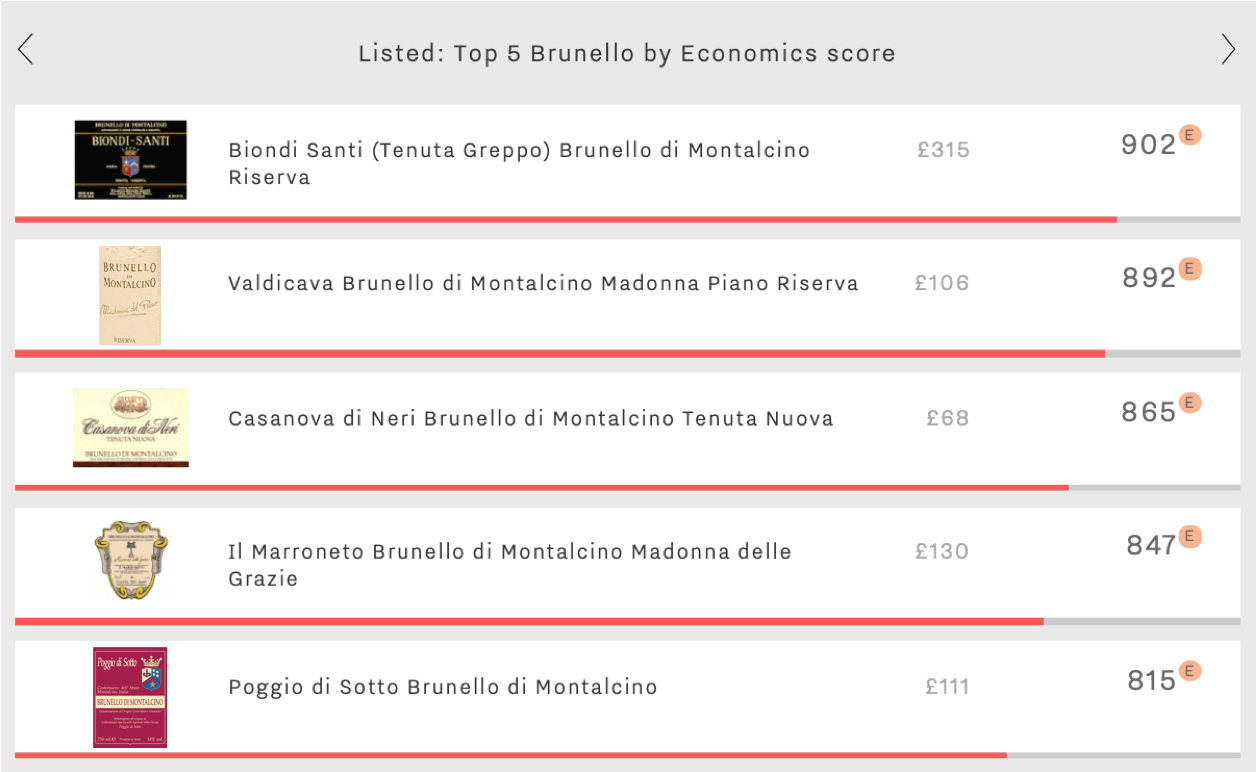
When examining the economic profile of Brunello wines, we see that Riservas tend to have higher Economics scores than Annatas, in line with their higher Quality scores. The best-performing Brunello by Economics score is Biondi Santi’s Brunello di Montalcino Riserva, with a score of 902. It earns the number one spot of this week’s top five with the highest price at £315 per bottle in-bond, and annual auction trading volumes of 458 bottles. The wine also outperforms the rest of the group for both Brand and Quality scores (904 and 938 respectively).
While Riservas are strong economically speaking, Annatas often have stronger Brand scores than their longer-aged counterparts, being produced in larger quantities and thus achieving greater visibility. In second place is Valdicava’s Brunello di Montalcino Madonna Piano Riserva, with an Economics score of 892, whereas its straight Brunello has a Brand score 57 points above its “big” brother, an example of the potential branding conundrum surrounding Brunello and other parts of Tuscany with a Riserva denomination. Nonetheless, the Riserva shows better price performance, with a compound annual growth rate (CAGR) of 15.2%, and an average of 257 bottles sold at auction annually.
Specific “crus” can also perform better than their straight Brunello Annatas in economic terms. In third place is Casanova di Neri’s Brunello di Montalcino Tenuta Nuova with an Economics score of 865. Despite having the lowest Quality score (841) and lowest price (£70) of the group, it earns this week’s second-highest Brand score (887).
In fourth place is Il Marroneto’s Brunello di Montalcino Madonna delle Grazie, the winery’s top cru, produced from grapes grown around the historic chestnut flour store house, and below the church by the same name. It has an Economics score of 847, benefitting from by far the best long-term price performance of this week’s top five, with a compound annual growth rate (CAGR) of 22.9%. Moreover, it sits just one point shy of this week’s number one in Quality terms (937) at 40% of the price – £130.
Rounding out the group is Poggio di Sotto’s Brunello, with an Economics score of 815.
While Super-Tuscans have been recognised for their investment potential for some time, Brunello still sits rather in the shadow of its Bordeaux-blend brothers. In Wine Lister’s first Tuscany market study, conducted in 2017, Brunello held nine places out of the top 25 Tuscan Economics scores. Today that number has increased to 14, as Brunello – Montalcino’s very own, highly ageworthy selection of the Sangiovese grape – goes from strength to strength.
With Christmas and New Year celebrations now behind us, the first Listed blog of 2019 has us dreaming of warmer climes. As an antidote to the January blues, we suggest a dose of California sun in the form of Chardonnay from Sonoma and/or Napa Counties. Below we examine the top five whites from the Golden State by Wine Lister score.
In the context of Chardonnay world-wide, it is worth glancing at regional differences to place the Californian scores in context. While the top five white Burgundies by Wine Lister score outperform their American counterparts by 147 points (953 for Burgundy vs. 806 for California), the Burgundian average price is over 15 times higher (£2,383 vs. £153).
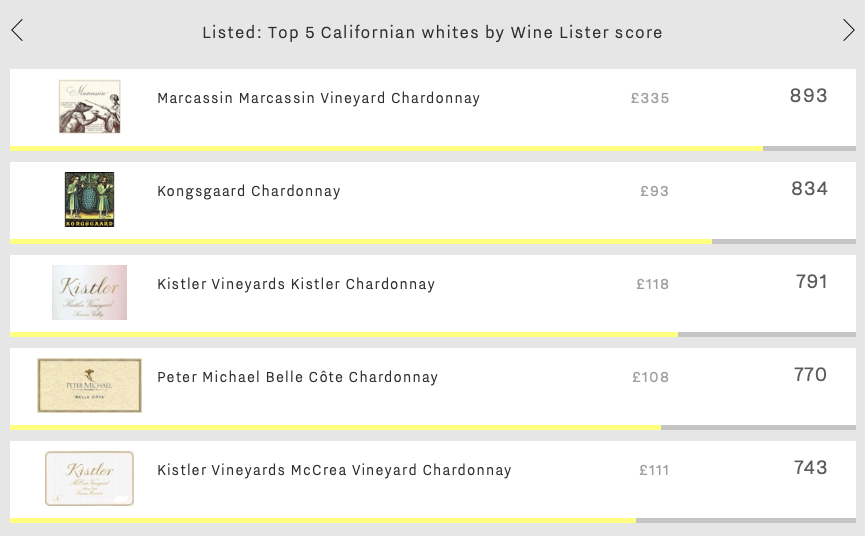
The first of this week’s top five is Marcassin Vineyard’s Chardonnay with a score of 893. Though it beats the other four wines in all three Wine Lister score categories (Quality 927; Brand 843; Economics 903), its Economics score sits 123 points above the next best Economics performer. This is thanks to achieving the highest market price of £335 per bottle (in-bond), and the largest volume of bottles traded in the past four quarters (353).
In second place is Kongsgaard Chardonnay with a score of 834. At vintage level it actually achieves the highest Quality score of all wines in the group – the 2013 earns 966 points, thanks to a score of 95+ from Wine Lister partner critic Antonio Galloni, who calls it “a real knock-out”. This is all the more impressive considering the wine’s average price of £93 per bottle in-bond – just over half the average of the group’s other four wines combined (£168). Given this price to quality ratio, it is perhaps unsurprising that Kongsgaard has the strongest restaurant presence of this week’s top five, featuring in 15% of the world’s best.
Next in this week’s top five is the first of two wines from Kistler Vineyards. Its straight Chardonnay and McCrea Vineyard Chardonnay earn 791 and 743 points respectively, placing them third and fifth. The straight Chardonnay’s Quality score of 892 sits just two points under the quality achieved by Kongsgaard, however its overall score is balanced by a much lower Economics score of 640. This is due to a recent price drop, resulting in short-term price performance of -10.3%. The performance of its sibling from McCrea Vineyard is quite the opposite, with the best short-term price performance of the group (7.7%), and the second-highest Economics score of this week’s top five (780).
Sandwiched between the two Kistler wines in fourth place is Peter Michael’s Belle Côte Chardonnay with an in-bond price of £108 per bottle, and a Wine Lister score of 770.
Wine Lister’s three-pronged rating system, which measures a wine’s Quality, Brand strength, and Economic performance, gives a uniquely holistic outlook on the world’s finest wines. Wine Lister’s Economics score comes courtesy of data partnerships with Wine Owners and Wine Market Journal, the former supplying price data and the latter auction trading volumes from the world’s major fine wine auction houses.
Thanks to an expansion of the data we receive from both Wine Owners and Wine Market Journal, we have recently added Economics scores, and therefore overall Wine Lister scores, to c.1,250 wines on Wine Lister.
Having examined the top overall scorers last week, below we look at the top 20 highest Economics scorers of this new batch.
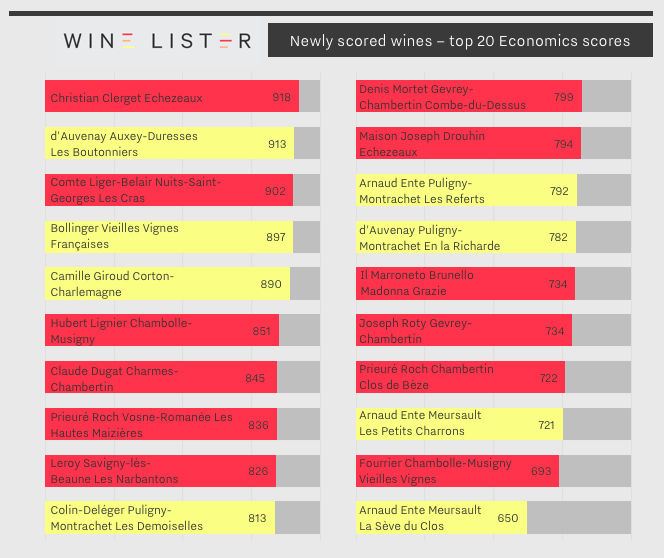
Whilst Burgundy represents 58% of wines newly-armed with full Wine Lister scores, the region claims 90% of the group’s top 20 Economics scores. Ten of these hail from the Côte de Nuits, earning an impressive average Economics score of 809, and including the best Economics performer of these newly-scored wines, Christian Clerget’s Echezeaux (918). Clerget’s Echezeaux has traded 48 bottles at auction over the past year, just over 1% of its 4,000-bottle annual production volume.
Next in line from the Côte de Nuits – and the only Nuits-Saint-Georges in the top 20 – is Les Cras from Domaine du Comte Liger-Belair, which takes the third-best Economics score of this new batch (902), despite having traded just 14 bottles at auction over the past 12 months. It does so thanks to excellent short and long-term price performance. It has added 20.2% to its price over the past six months and recorded a three-year compound annual growth rate (CAGR) of 25.4%. It also has a high average price of £394.
The Côte de Beaune features eight times, with Domaine d’Auvenay’s Auxey-Duresses Les Boutonniers coming second overall with a score of 913. However, Puligny-Montrachet takes the lion’s share of the Côte de Beaune’s spots. The first is Colin-Deléger Les Demoiselles with a score of 813, its strong economic performance is the result of a three-year CAGR of 24.4%.
While Arnaud Ente is represented in Puligny-Montrachet by Les Referts, which achieves an Economics score of 792, the domaine features more prominently in Meursault, taking two spots with Les Petits Charrons (721) and La Sève du Clos (650). The latter also records the highest Quality score of any Burgundy in this group (952).
Interestingly, the number one overall scorer of the 20 is in fact one of only two non-Burgundian wines to feature. Champagne Bollinger Vieilles Vignes Françaises achieves a Wine Lister score of 923, at least 98 points ahead of any of the other 19 wines featured here. Its Economics score of 897 is thanks to a three-month average price of £712, a three-year CAGR of 13.8%, and having traded 128 bottles at auction over the past year.
Other wines from the newly-scored list to feature in the top 20 Economics scores are: Domaine Leroy Savigny-lès-Beaune Premier Cru Les Narbantons, Camille Giroud Corton-Charlemagne Grand Cru, Maison Joseph Drouhin Echezeaux Grand Cru, Domaine Prieuré Roch Vosne-Romanée Les Hautes Maizières, Domaine Claude Dugat Charmes-Chambertin Grand Cru, Domaine Hubert Lignier Chambolle-Musigny, Domaine Prieuré Roch Chambertin Clos de Bèze Grand Cru, Domaine Joseph Roty Gevrey-Chambertin, Domaine Colin-Deléger Puligny-Montrachet Premier Cru Les Demoiselles, Il Marroneto di Mori Alessandro Brunello di Montalcino Madonna Grazie, Domaine Fourrier Chambolle-Musigny Vieilles Vignes, and Domaine Denis Mortet Gevrey-Chambertin Combe-du-Dessus.








 Browse the full MUST BUY list
Browse the full MUST BUY list 
 Wine Lister’s dynamic Vintage Value Identifier chart, showing price vs. quality (left) and Value Pick score (right).
Wine Lister’s dynamic Vintage Value Identifier chart, showing price vs. quality (left) and Value Pick score (right). Hubert Lignier Clos de la Roche 2016’s six-month price performance compared to performance of other Clos de la Roche Grand Cru 2016s
Hubert Lignier Clos de la Roche 2016’s six-month price performance compared to performance of other Clos de la Roche Grand Cru 2016s Armand Rousseau’s average price performance over two years
Armand Rousseau’s average price performance over two years 



